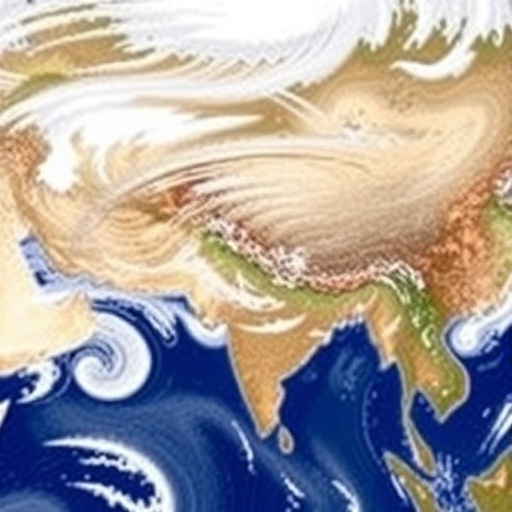A groundbreaking study has unveiled a previously unrecognized mechanism through which the North American continent exerts a profound influence on the Asian summer monsoon, reshaping our understanding of global climate dynamics. Published in the prestigious journal Science Advances on September 5, 2025, the research reveals that summer heating over North America triggers atmospheric processes that significantly enhance rainfall across East and South Asia. This discovery underscores the intricate teleconnections embedded within Earth’s climate system and highlights the far-reaching impacts of regional land surface changes.
For decades, climatologists have emphasized the dominant role of Eurasian landmasses, particularly the expansive Tibetan Plateau and Himalayas, in driving the Asian monsoon. These elevated terrains act as thermal engines that shape atmospheric circulation patterns, facilitating seasonal monsoon rainfall essential to over a billion people. However, the new findings from an international collaboration involving the University of Bristol and the Institute of Tibetan Plateau Research challenge this conventional narrative by demonstrating a nearly equally significant role for North America in modulating monsoon intensity.
Using advanced climate modeling techniques, the researchers simulated a series of idealized Earth scenarios starting with a water-covered globe devoid of continents. By progressively introducing continents such as Eurasia, Africa, India, Australia, Antarctica, and importantly, North and South America, the team meticulously analyzed how these landmasses influence monsoon characteristics. Contrary to initial hypotheses, where nearby Australia was expected to have a major impact due to its proximity, North America emerged as the most influential extra-Asian continent enhancing monsoon precipitation.
At the core of this mechanism is the intense summer heating of the North American continent, which establishes a robust thermal center. This localized warming generates atmospheric ripple effects that amplify the North Pacific subtropical high-pressure system, a semi-permanent anticyclone influential in controlling weather patterns across the Pacific. The strengthened high-pressure system, in turn, expands the northern extent of the Hadley cell—an equator-to-subtropics atmospheric circulation pattern—thereby intensifying westward winds that advect moisture from the Pacific Ocean towards Asia.
The consequence of these altered wind patterns is a deepening of convection over East and South Asia, fostering more vigorous monsoonal storms and increased rainfall. Such moisture influx is crucial for sustaining agriculture, ecosystems, and human livelihoods across these densely populated regions. The amplified monsoon rainfall observed under this North American influence is remarkably substantial—almost half as potent as the renowned effect of the Tibetan Plateau on East Asian summer precipitation.
These insights carry profound implications in the context of anthropogenic climate change. As human activities continue to modify land surface characteristics in North America through urbanization, deforestation, and agricultural practices, the continent’s heating patterns during summer may shift, potentially intensifying or altering the teleconnections identified. Consequently, this could exacerbate monsoon variability and the frequency of extreme hydrological events such as floods and droughts in Asia, creating complex challenges for climate adaptation and disaster risk management.
Lead author Linlin Chen, a PhD candidate in Physical Geography at the University of Bristol, expressed that traditional frameworks have narrowly focused on Eurasian influences when examining drivers of Asian monsoon variability. This pioneering study broadens the perspective by quantifying how remote continental heating can teleconnect across the Pacific and materially affect rainfall patterns thousands of kilometers away. “Earth’s climate functions as a highly integrated system,” Chen noted, “and appreciating the cross-continental feedbacks is essential for accurate climate projections.”
Dr. Alex Farnsworth, senior research associate at the University of Bristol and collaborator from the Chinese Academy of Sciences, highlighted the unexpected nature of the findings. The research team initially hypothesized Australia might exert a dominant influence due to geographic closeness and known climatological roles but were surprised when North America decisively outperformed. This revelation prompts a reevaluation of global climate modeling frameworks to better incorporate such teleconnections and improve predictive skill.
The study’s methodology, which involved a sequential introduction of continental landmasses into model simulations, provided a novel experimental framework to isolate and investigate the individual contribution of each region to monsoon dynamics without confounding factors. This approach enhances confidence in attributing specific atmospheric responses directly to North American summertime heating, advancing the scientific understanding beyond correlational analyses prevalent in previous work.
Moreover, co-author Professor Paul Valdes from the University of Bristol emphasized the broader message concerning climate responsibility. The interconnections uncovered reveal how changes in one hemisphere’s land surface can ripple through to affect climatic conditions elsewhere, reinforcing the imperative for global cooperation in mitigation and adaptation efforts. As local modifications bear global consequences, coordinated action becomes not merely ethical but scientifically necessary to manage future climate risks.
The implications extend toward improving predictive regional climate models, which must now factor in North American influences when simulating Asian monsoon behavior. Given the societal dependence on monsoon stability for agriculture, water resources, and energy in Asia, this research provides essential scientific groundwork for policymakers, planners, and vulnerable communities facing the impacts of a rapidly evolving climate system.
This study represents a significant leap in climatology by articulating how intercontinental atmospheric interactions can shape some of the planet’s most critical weather phenomena. By revealing North America’s active role in modulating Asian monsoon intensity, it sets a precedent for exploring other remote teleconnections and underscores the complex, interwoven nature of Earth’s climate system.
Subject of Research: People
Article Title: ‘The role of the North American continent in strengthening the Asian summer monsoon’
News Publication Date: 5-Sep-2025
Image Credits: Linlin Chen
Keywords: Anthropogenic climate change




